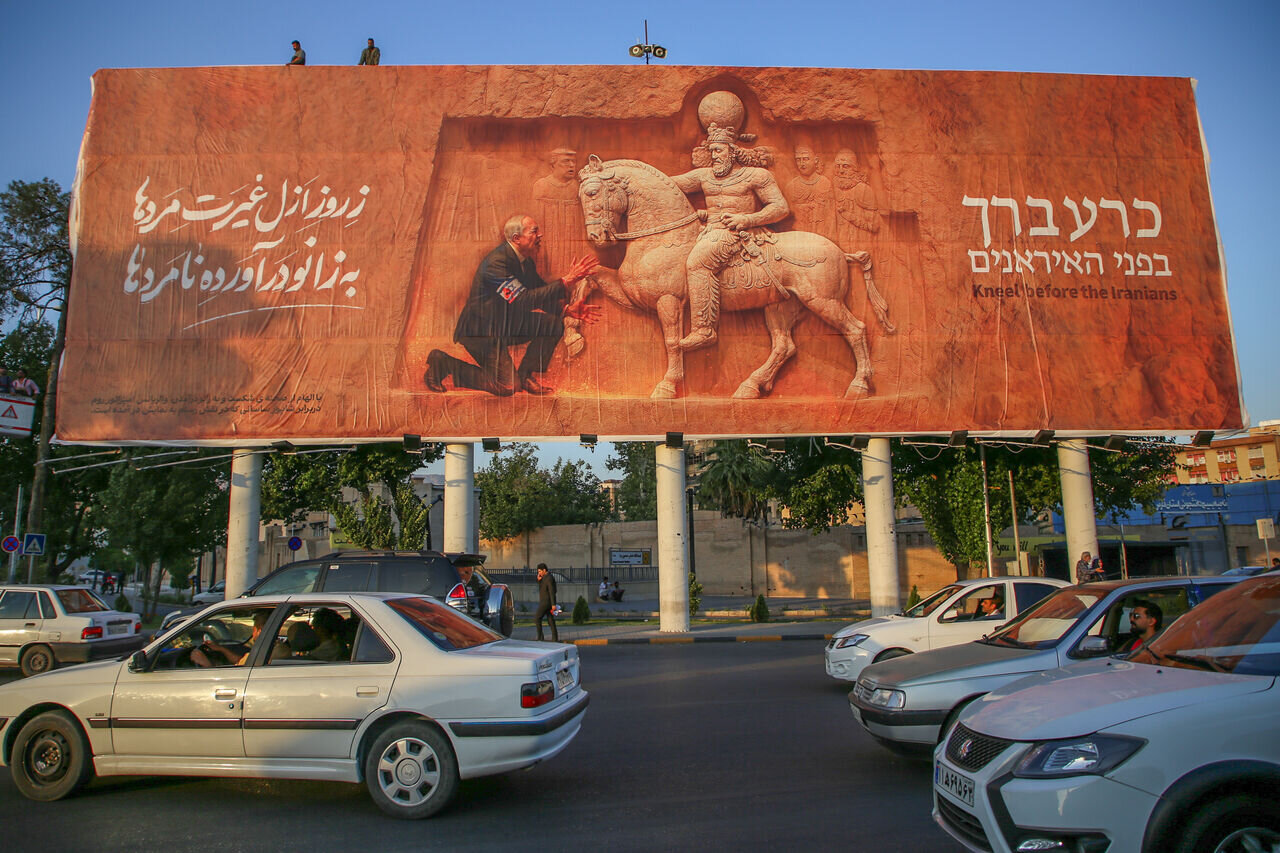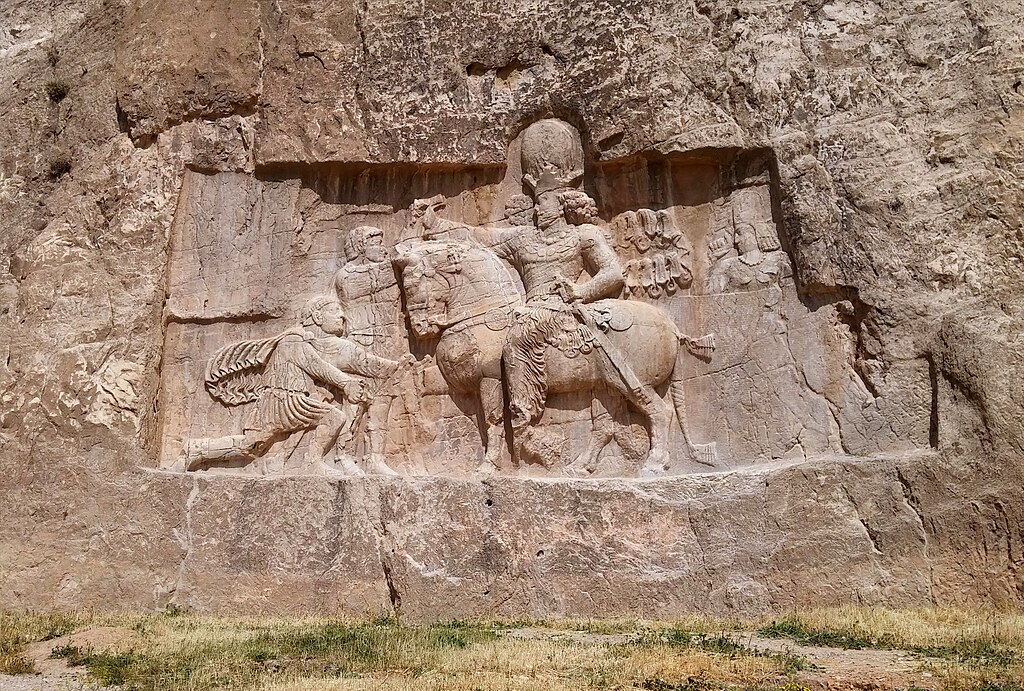Triumph of ancient civilization of Iran over enemies depicted on huge billboard in Shiraz

Tehran – A new large billboard at Imam Hussein (AS) Square in Shiraz, Fars Province, tells the story of the triumph of the ancient civilization of Iran, whether it be over the Roman Emperor Valerian about a millennium ago or the Zionist aggressors in the modern day.
The vast land of Iran, due to its strategic geographical position, has throughout history often been coveted by oppressive invaders. Yet, this land has never been devoid of brave and honorable men and women who have always defeated the aggressors throughout history, IRNA reported.
Three ancient rock reliefs in Persepolis, Darab, and Tang-e Chogan in Kazerun, Fars Province, are nationally and even globally renowned for depictions of the Sassanid emperor Shapur I’s victory over the Roman emperor Valerian.
Following the defeat of the Roman army by Shapur I, Roman soldiers, commanders, and their leader Valerian were taken captive. In honor of this great victory, Shapur ordered the scene to be carved into stone in multiple locations.
These Sassanid-era carvings have now inspired the newly unveiled billboard in Shiraz. According to Vahid Namazi, head of the Fars branch of the Art Bureau, the designer of the billboard is Saeed Karimi, a distinguished graphic artist from Fars Province.
“Once again, the artists of Fars have stood beside the people and, through the language of art, remind us of the greatness and honor of Iran and its people,” Namazi said.
He added that the usurping Zionist regime and its American overlords, for years, under the guise of Western civilizational superiority, have pursued a path of oppression, aggression, plunder, and coercion. Oppressed nations around the world have suffered under their tyranny, while international bodies that claim to uphold peace and justice have remained passive. Some rulers of Islamic countries, through their silence and indifference, have effectively endorsed such savage behavior.
“After thousands of days of oppression and child-killing in Gaza, the criminal Zionist regime dared to turn its eyes toward the heart of the Islamic world, Iran, based on flawed analysis and misguided advice. However, it faced a serious and sobering response from the Iranian nation, bringing it back to reality and out of its delusions,” Namazi added.
“There was a need to remind the Western countries of the civilizational might of the Islamic Republic of Iran and to make them understand that they are confronting a nation with more than three thousand years of cultural and civilizational legacy, one whose strength lies not in military weaponry but in the beliefs, traditions, and heritage of its people,” he concluded.
“This billboard in the historic city of Shiraz, once again, echoes the enduring legacy and power of the Iranian nation. In these turbulent times of war, it reminds the child-killing Zionist regime and its uncivilized patrons that, like those before them, they too shall soon kneel before the Iranians.”

Shapur I’s victory relief at Naqsh-e Rostam is a rock carving located three kilometers north of Persepolis. It is one of the eight Sassanid rock carvings in Naqsh-e Rostam.
The relief depicts a scene in which Valerian, the Roman Emperor, is kneeling before Shapur I and asking for mercy.
Shapur I, the Sasanian King of Persia, captured the Roman Emperor Valerian after the Battle of Edessa, which took place in Edessa (now the Turkish city of Urfa) in 260. This event is considered a significant humiliation for the Roman Empire and was a major victory for Shapur. The capture of a Roman emperor was unprecedented and became a symbol of Sasanian power.
In the carving, Shapur I is riding a big horse with a royal crown and a decorated robe. Valerian is depicted with a Roman crown and a robe on his shoulder, as if he had rushed to the king’s horse of Iran and knelt down. Valerian stretched out both hands as a sign of forgiveness. The greatness of the king of Iran can be clearly seen in the crown, bracelets, and hairstyle, as well as the saddle and bridle of his horse.
Saeed Karimi’s artwork is a modern version of that rock relief. While the rider remains Shapur I, as in the ancient carving, the kneeling figure has been digitally altered to represent a contemporary warmonger, wearing an armband with the Israeli flag, and he is none other than Benjamin Netanyahu, Prime Minister of Israel.
The background features the original stone-carved figures but is augmented with a strong message, reinforced by the Persian, Hebrew, and English text: “Kneel before the Iranians”.
There is also a verse line written on the billboard, which reads: “Since the dawn of time, the honor of true men; Has brought the dishonorable down to their knees”.
The artwork, together with the text message and verse line refers to the recent brutal aggression by the Zionist regime against Iran.
In the early hours of June 13, Israel launched an unprovoked, large-scale armed attack against Iran. This was an egregious act of aggression by every definition.
Up until June 24, through coordinated air, missile, and drone strikes, it targeted residential neighborhoods, civilian infrastructure, public authorities, and nuclear facilities subject to International Atomic Energy Agency (IAEA) safeguards, which resulted in the martyrdom of senior military commanders, prominent scientists, and innocent civilians, including women and children.
In response to the Israeli aggression on Iranian territory, the Islamic Revolution Guard Corps (IRGC) has launched a large-scale retaliatory operation, codenamed “True Promise 3,” targeting multiple Israeli military and air bases through coordinated missile and drone strikes deep inside occupied territories.
The war between Iran and Israel came to a halt on June 24, after a dizzying 12 days in which the world watched President Donald Trump demand the evacuation of Tehran's 10 million residents, threaten to assassinate Iran's Leader, advocate for “regime change,” and launch strikes on Iranian nuclear sites.
On the other hand, for 12 days, Iranian missiles and drones rained down on the occupied territories without pause, leaving at least one-third of Tel Aviv in ruins. Similar scenes were witnessed in other major cities like Haifa and Be'er Sheva, and critical military and intelligence sites were destroyed by Iranian weapons.
SS/SAB
Leave a Comment